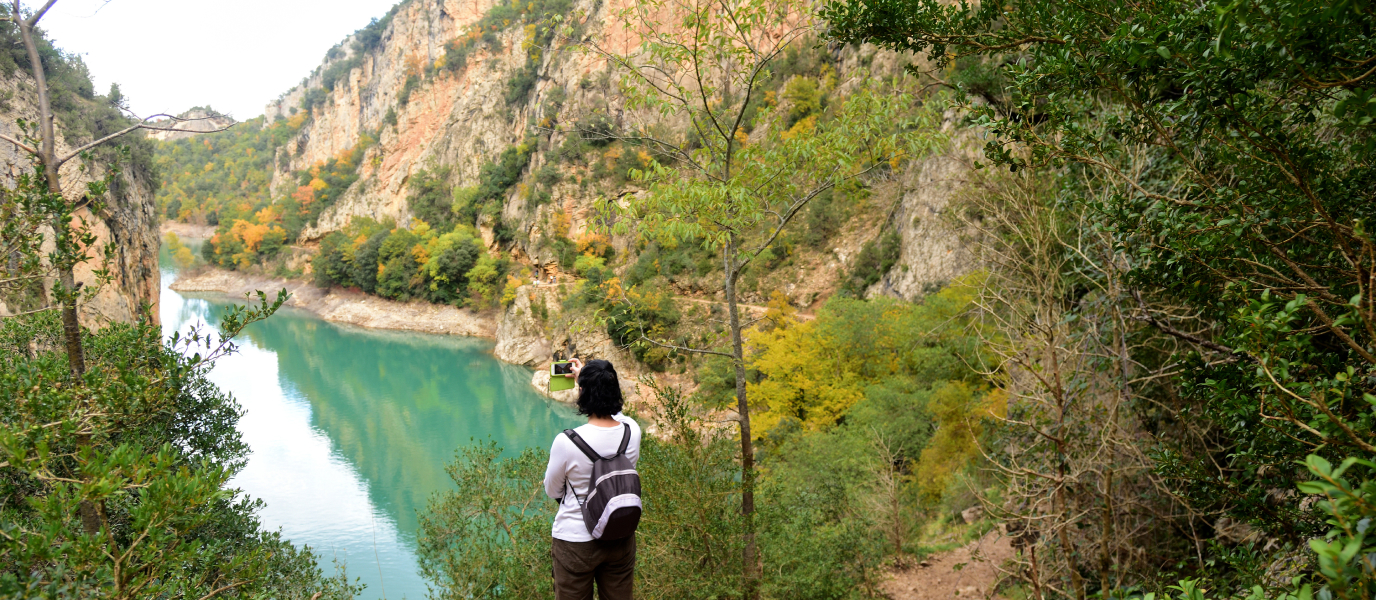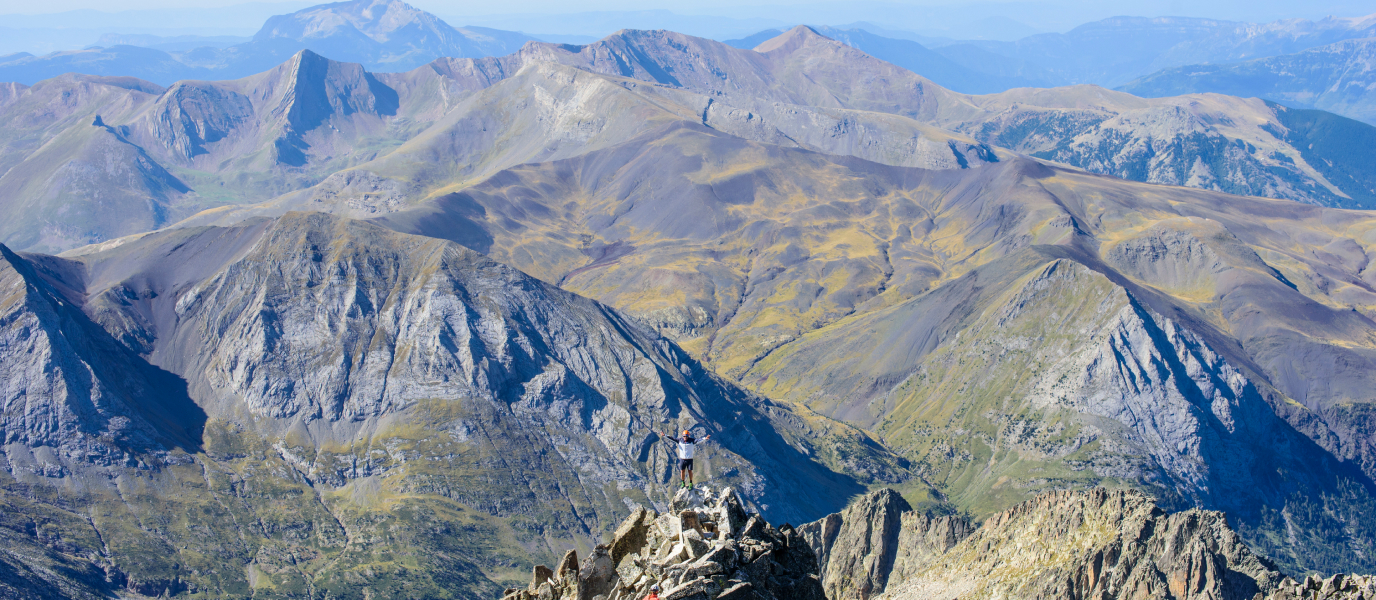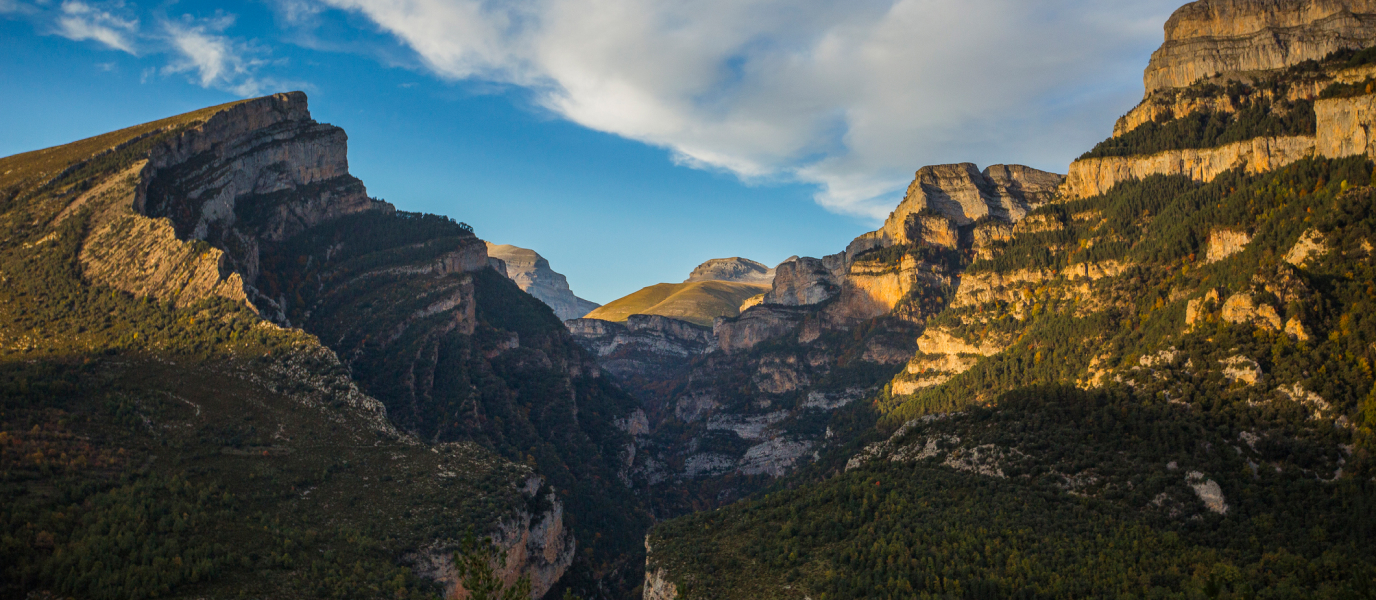The province of Huesca holds seemingly endless surprises. In the west of the province, in the heart of the Pyrenees, and not far from the border with Navarre, the Selva de Oza seems to be a natural space with its own particular character within the unique ecosystem that comprises the Pyrenees.
The outstanding feature of the Selva de Oza is its luxuriance. This impressive stretch of woodland stretches from the feet of mountain peaks that rise to a height of over 2,500 metres. Welcome to the spellbinding Selva de Oza. We are in the valle de Hecho, which lies within the Valles Occidentales Natural Park, at the far west of the Aragon Pyrenees, in the county of La Jacetania.
To help us orientate ourselves, the Selva de Oza lies at the end of the A-176, the province of Huesca’s last road into the Pyrenees before Navarre. It is the next valley to the west of the River Aragon valley leading to Canfranc, and to the Somport mountain pass. However, the Selva de Oza road does not cross into France: instead it ends here, in this magical place.
How can we visit the Selva de Oza? What can we do there? In this article, we tell you about the main way to explore this natural space in depth, and about some of the best restaurants, with recommendations of where to eat.
Tours and hiking trails for all
There are several tours that visitors can undertake in the Selva de Oza area. However, before we go into the different nooks and valleys hidden among the mountains, it is worth looking at what gives the forest its name.
A possible starting point is the Megalitismo Pirenaico [Pyrenees Megalith] Interpretation Centre, located on the approach road to the forest. The museum organises fairly short guided tours which will help us to understand this natural setting.
The forest is a dream come true for hiking and trekking enthusiasts, and allows walkers to move from the luxurinat woodland ecosystem to the true high mountain landscape. If that is what you’re looking for, and you’d like to explore this area in all its glory, make sure you don’t miss our information on the best hiking trails in the Selva de Oza.
Trail to the Ibón de Acherito
This is one of the best-known trails that lead to one of the most breathtaking scenes in the entire park. For the uninitiated, an ‘ibón’ is a mountain lake of glacial origin. An ascent to the Ibón de Acherito is key to understanding the majesty of the Pyrenees. The trail begins at the La Mina car park, and climbs for 5 kilometres to reach the lake, which lies at an altitude of 1,880 metres. It is the most western lake in the Pyrenees.
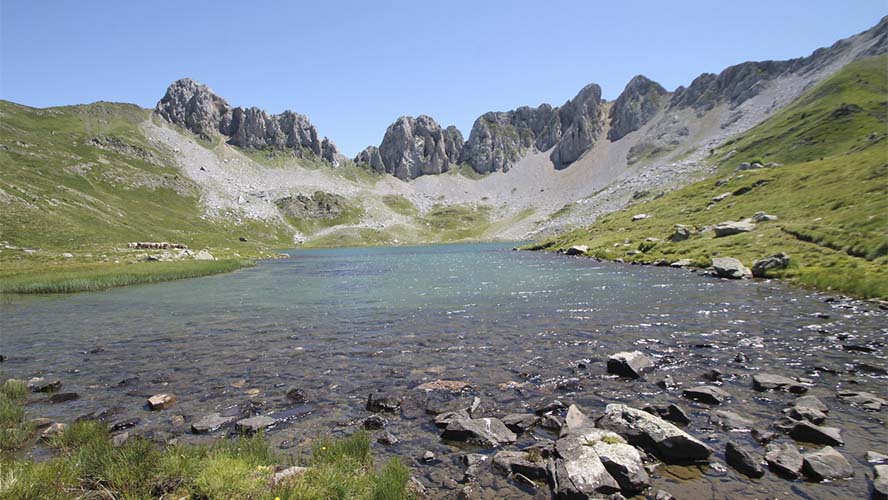
Trail to the valley of Aguas Tuertas
Another of the park’s most popular trails leads from the Selva de Oza, and climbs to the hidden valley of Aguas Tuertas, a stunning high mountain landscape very close to the French border. The climb of barely three kilometres, starts from the Selva de Oza campsite’s car park, and follows the course of the Aragón Subordán river, passing through the Guarrinza car park. Walkers will catch sight of waterfalls on the way to their spectacular final destination. There is also a surprise in store: the Aguas Tuertas dolmen, which still stands as a megalithic sign that this place, at an altitude of 1,620 metres, was once inhabited.
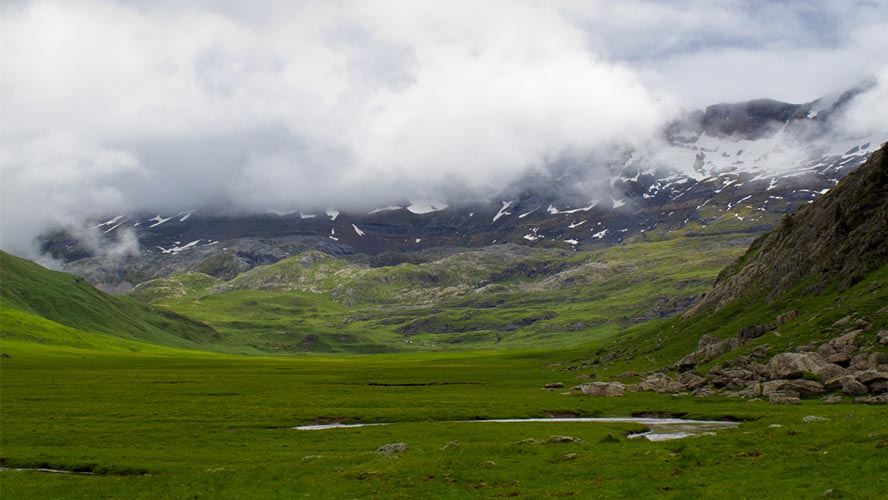
Trail to the Ibón de Estanés
Taking the same path as we took for the valley of Aguas Tuertas, we take a turn-off to another mountain lake, and another landscape known only to the mountain itself, the Ibón de Estanés. Climbing up from the Guarrinza car park, we take the same route as before as far as the mountain hut near the Aguas Tuertas dolmen.
At this point, we will see a path on the right that leads through a valley to the Escalé pass, at an altitude of approximately 1,900 metres. Now comes the most difficult section of the trail. Having reached this point, we simply have to go on to the magnificent Ibón de Estanés, another glacial lake, at an altitude of 1,777 metres. Now we are very close to the French border, and very near the Candanchú ski resort, from which another hiking trail leads to this point. A continuous and demanding eight-kilometre climb to reach this glorious sight.
Trail to the Castillo de Acher
As if so many peaks, mountain lakes and meadows were not enough, now we are going to discover a most unconventional castle — one formed by nature. Perched at the summit of a mountain, in the manner of an impregnable fortress, the Castillo de Acher is a favourite haunt of those who love exploring the Selva de Oza area.
This is a legendary and demanding climb, not suitable for novices, which reaches an altitude of 2,384 metres, with an ascent of 1,270 metres. The total length of the trail is 13 kilometres, and progress is slow, taking over six hours, to reach this particular rooftop of the western Pyrenees. The trail starts at the Ramiro del Monje car park. A path leads from here through a pine wood, and gradually rises to the final ascent.
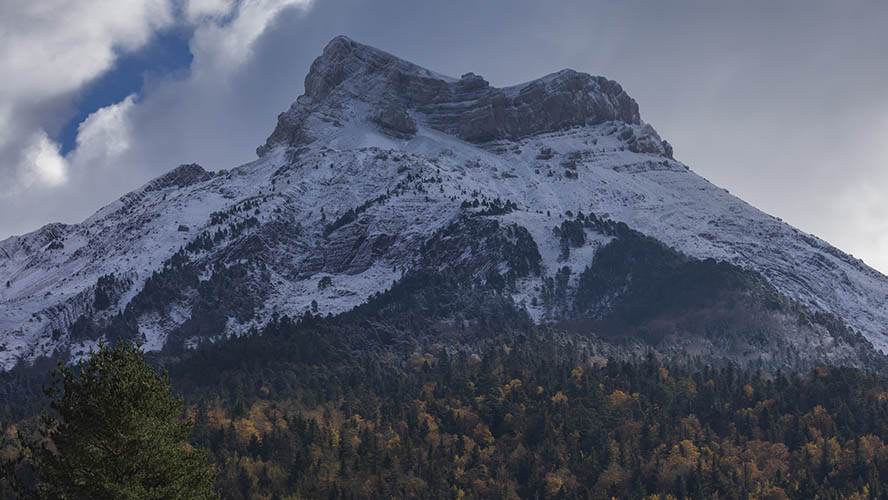
Where to eat in the Selva de Oza
Typical mountain cooking, such as stews, soups or Huesca casserole, comprises the gastronomy to be enjoyed in some of the restaurants and ‘bordas’ [local canteen-type eateries] dotted around the Selva de Oza area. The area’s traditional eateries are known as ‘bordas’, former shepherds’ cottages that have been converted into little restaurants.
Some of the most popular bordas and restaurants are:
- Borda Bisaltico: located in the heart of the Selva de Oza. Essential if you want to try authentic ‘borda’ cooking.
- The Selva de Oza campsite restaurant: traditional cuisine and good chargrilled dishes in this campsite located inside the natural park.
- Bar Costeros Oza: this place attracts visitors with its summer terrace in the shadow of a spectacular beech tree.
- Castillo d’Acher Restaurant: this grill restaurant is in Siresa, the nearest village to the forest.
Useful information
- How to ge to the Selva de Oza: by car, the road leading up to the Selva de Oza starts at the Puente La Reina de Jaca, a village between Pamplona and Jaca. From there, the A-176 road leads uphill to Hecho, Siresa, and finally to the Selva de Oza.
- Further information: in the nearby village of Hecho, there is a tourist office where visitors can obtain more information about the valley of Hecho, the Selva de Oza and other places of interest.
Qué puedes ver de camino a la Selva de Oza
Enclavada entre valles y montañas pirenaicas, llegar a la Selva de Oza requiere de un buen paseo, por decirlo de alguna manera. Por supuesto, ese viaje está lleno de posibilidades, de sorpresas, de escalas obligadas, de esas que nadie debería de pasar por alto.
-
Jaca, capital de los Pirineos
Para quienes vienen del sureste, una visita imprescindible es la ciudad de Jaca, la primera capital del reino de Aragón y hoy capital de los Pirineos. La Catedral de San Pedro, uno de los ejemplos más relevantes del románico pirenaico; la imponente Ciudadela de finales del siglo XVI, único edificio militar en su tipo que se conserva, al completo, en Europa; el edificio renacentista del Ayuntamiento, la antigua judería, las murallas…, así como sus calles y plazas llenas de vida, son solo algunos de los innumerables atractivos de este maravilloso destino.
-
Monasterio de San Juan de la Peña, cuna de Aragón
No muy lejos de Jaca se encuentra San Juan de la Peña, un lugar mágico que conecta con la rica historia de Aragón. Ahí se puede visitar el Monasterio Viejo, una joya del románico construida, enclavada en la roca, a principios del siglo X, y el Monasterio Nuevo, un espléndido ejemplo de arquitectura barroca que comenzó su construcción en 1676. En el interior de este último se encuentra el Centro de Interpretación del Reino de Aragón (CIRA) y el Centro de Interpretación del propio Monasterio de San Juan de la Peña, dos visitas más que interesante.
-
Santa Cruz de la Serós, encanto medieval
Saliendo de San Juan de la Peña, este pequeño pueblo medieval ofrece dos auténticas joyas del románico: la iglesia de Santa María, un antiguo monasterio femenino de los siglos XI y XII, y la ermita de San Caprasio, un bonito ejemplo de románico lombardo del siglo XI.
-
Puente de la Reina de Jaca, el cruce de caminos
Antes de dejar atrás del valle del río Aragón para internarse en la cordillera, hacia la Selva de Oza, hay que pasar por esta antigua encrucijada. El puente original, al que debe su nombre la localidad, ya no existe, pero el actual, del siglo XIX, nos recuerda que este cruce sobre la confluencia del río Aragón y el Aragón Subordán fue, y sigue siendo, un punto clave del Camino de Santiago, comunicando los valles pirenaicos con el eje Jaca-Pamplona.
-
Monasterio de Leyre, entre cantos gregorianos
Si, por el contrario, el viajero viene del oeste, una de las visitas imprescindibles es este monasterio benedictino. La cripta del siglo XI, la bóveda gótica, el panteón de los primeros Reyes de Navarra y la “Porta Speciosa“, un excepcional pórtico románico del siglo XII, son solo algunos de los atractivos de este lugar que constituye uno de los conjuntos monumentales más interesantes de Navarra.
-
Castillo Museo de Javier, cuna del patrón de Navarra
También en el entorno del embalse de Yesa, en la localidad de Javier, se encuentra este singular castillo del siglo X. Cuna de San Francisco Javier, cofundador de la Compañía de Jesús y patrón de la Comunidad Foral, esta fortaleza medieval construida sobre la roca viva conserva su torre almenada, su puente levadizo, sus mazmorras, matacanes, troneras y saeteras; una joya histórica de frontera entre Aragón y Navarra.
-
Artieda, Mianos, Martes y Arrés, en la ribera del Aragón
Ya en territorio aragonés, esta sucesión de pequeños pueblos medievales, más o menos alineados al cauce del río Aragón, ofrece una interesante colección de edificios defensivos, iglesias, casonas, callejuelas y plazoletas, en muchos casos ligadas, por supuesto, al Camino de Santiago.
-
Hecho, capital del valle
Dejando atrás el valle del Aragón, toca, por fin, comenzar a subir la montaña, para adentrarse en el valle de Hecho. La localidad, que precisamente le da nombre al propio valle, es un bonito conjunto de calles y casas de piedra, típicamente pirenaico y muy bien conservado. La Iglesia Parroquial de San Martín, el Museo etnológico de Casa Mazo y el Museo de Escultura Contemporánea al Aire Libre son algunos puntos a destacar.
-
Monasterio de San Pedro de Siresa
Muy cerca de Hecho, en Siresa, este singular monasterio románico conserva los restos del que posiblemente fuera el monasterio más antiguo de Aragón. Su origen es del siglo IX, aunque se considera que puede ser incluso previo, de época visigoda. Se dice también que en este lugar fue bautizado y pasó sus primeros años el rey Alfonso I El Batallador.
-
Ansó, digno colofón
Miembro de la red de “Los pueblos más bonitos de España” y, desde 2006, declarado Bien de Interés Cultural por el Gobierno de Aragón como conjunto histórico-artístico, el pueblo de Ansó, en el vecino valle del mismo nombre, bien puede ser la manera perfecta de cerrar un viaje a la Selva de Oza. No hay que perderse su enorme iglesia fortificada de San Pedro, ni su Museo del Traje Ansotano, pero, sobre todo, hay que disfrutar el encanto de su singular casco urbano.
Lugares como Sangüesa y Sos del Rey Católico, por el oeste, y Sabiñánigo y la comarca del Alto Gállego, al este, e incluso Huesca, también suponen escalas más que interesantes para visitar antes o después de descubrir la Selva de Oza, aunque ya se trata de lugares más lejanos.




































































